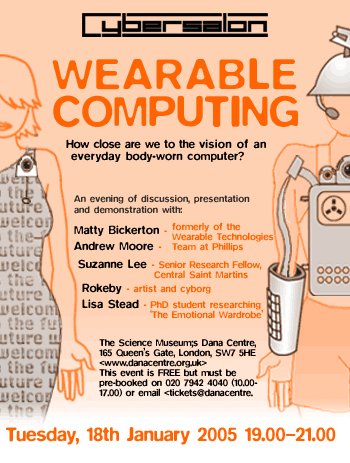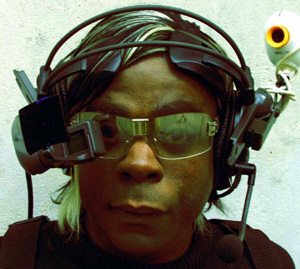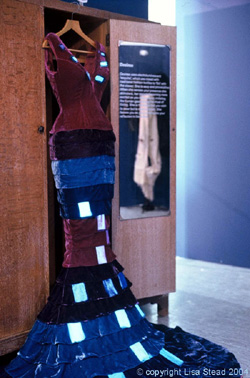ABOUT 'WEARABLE COMPUTING'

CONTRIBUTE TO THE DISCUSSION BEFORE, DURING AND AFTER THE EVENT BY VISITING THE WIRELESS UTOPIAS WIKI HERE.
PUT QUESTIONS TO THE PANEL VIA EMAIL IN ADVANCE OF AND DURING THE EVENT <questions@cybersalon.org>.
BIOGRAPHIES
Panelists
Suzanne Lee
Central Saint Martins

Suzanne is a Senior Research Fellow in Fashion at Central Saint Martins. She is currently writing a book entitled 'Fashioning The Future' to be published by Thames & Hudson in 2005. It imagines a future wardrobe based on contemporary technology R&D. With a background in both fashion design and digital arts her research centres on the creative potential offered by technology. She has exhibited highly acclaimed interactive installations at the ICA in London, The Kunstlerhaus Vienna, CCAC San Francisco and numerous other international locations and events. She has curated fashion for the British Council and is a creative consultant for fashion designers including Hussein Chalayan and Hamish Morrow in London.
Rokeby

Rokeby is a British artist, Cyborg and Internet pioneer who lives and works in London. Working on some of Britain's most innovative multimedia projects, he was one of the founders of Cerberus (1994), which was the first company in the world to distribute and sell music over the Internet. He was also creator of the 'VNC - Virtual Nightclub' , published by Phillips - one of the first interactive movies to be released.
Rokeby's interactive media art encompasses portraiture, artificial intelligence, video, sound installations, live art and music performance. He has exhibited in group and solo shows in Japan, Europe and the USA. His interdisciplinary media practice combines science, technology, art and philosophy exploring the relationship between human identity, memory, spirituality and biotechnology with particular reference to wearable computers, cybernetics and the use of EEG brainwave monitors to create brain/ computer interactions.
His most recent work, MEMEX: A Cyborg Pilgrimage in The Age Of Amnesia (2003) saw him transform himself into a cyborg; embarking on a 40 day pilgrimage throughout London. R ecording the differing ideas to identity, existence and spirituality in the twenty first century the pilgrimage crossed certain murder spots. At the exact locations of murder, the cyborg went into deep meditation, recording his EEG brain signals and converting them into music. Rokeby will continue the rest of his life as a cyborg recording his life as art and plans to transmit his stream of consciousness portraiture and EEG brain signals, live on the web later this year with the launch of Rokeby.TV.
Matty Bickerton
Since August 2004 Matty Bickerton
has been a Director of JKID Ltd. an inventions house specialising in
the area of toys and playthings. Prior to this he was a senior scientist
at Philips Research Labs, and project leader for the wearable electronics
research activity. He has published papers and spoken on designing for
wearability and the development of wearable technologies at numerous
events, including, SXSW 02, Wearables 02, Eurowearables03 & 04.
Andrew Moore
Andrew studied Electronic and Computer
Engineering at the Robert Gordon University from 1994 to 1998, then joined
Philips Research Laboratories at Redhill to work on their Context Awareness
and Wearable Technology projects. In 2002, he left to study Industrial
Design Engineering at the RCA. Having graduated last summer, he is now
working as a freelance Industrial and Electronic Designer.
Chair
Monica Biagioli
Monica
is an artist and Senior Lecturer in digital media in
the Graphic Design department at Surrey Institute of Art & Design.
Recently she has been working on a three-part series of handbags. The
first series was created for the 2003 Venice Biennale and focused on
the politics of branding. She followed that up with a series of handbags
focusing on the political tension between east and west Germany after
reunification. Currently she is developing the Cyberhandbag Series for
Cybersalon, dealing with Wearable Technology and the role of gender in
technology. Part of that
work involves developing the Venus Rising project, exploring female contributions
to the development of technological innovation.
Presentations
Lisa Stead

Lisa is a final year PhD student her research, 'The Emotional Wardrobe': A Fashion Perspective on the Integration of Technology and Clothing, is funded by the AHRB as part of 'Fashion and Modernity'. The aim of the PhD study is to marry fashion aesthetics with material science and electronics technology to provide reactive emotional aesthetics and interactive personalisation for the wearer. This research will be extended in 2005 in 'The Emotional Wardrobe' a AHRB/EPSRC funded project looking at 'Designing for the 21 st Century'. Lisa has presented at 2AD in Bristol and on 'Go Digital', a BBC World Service technology programme. She has published papers in Computers and Graphics and Personal and Ubiquitous Computing. Lisa has 7 year's experience working as a mens and boyswear head designer for suppliers to BHS, Topshop and C&A. For the last 6 years she has lectured on/directed various fashion and art and design courses.
The Emotional Wardrobe

The Emotional Wardrobe is a collection of garments that represent and stimulate emotional response through technology-enhanced aesthetics. By combining traditional fashion textiles, material science and affective computing, garments are given the ability to change their aesthetic display in response to the emotions of the wearer or the presence of a viewer.
The Emotional Wardrobe comprises of both worn and unworn garments (the unworn garments are installation pieces).
Imagine......If your clothing could transform its colour or pattern in response to a change in your emotions?
How would you feel showing your emotions to the world and how would the world respond to you?
The worn garment scenario aims to integrate technology from affective computing (the Affective Wear platform) and material science with fashion to create customisable aesthetics, which could also provide another level of communication.
The garment responds to the wearer via body sensors, translating an inferred change in emotional state with a change in the garment aesthetics. Light (L.E.D.s) is used to create 'poetic' patterns of colour, which glow from behind contours in the dress. The aesthetics are inspired by research into body language and the rhythmic patterns associated with music and emotion and could be used to improve self-awareness of moods or enhance and explore social interaction and self-expression. This concept provides a human-centric context to the technology, to encourage and facilitate human-human interaction between the wearer and society.
What if.......your clothing could communicate?
What if..... . your garments had personalities, how would they act and react to you?
The group of unworn garments 'live' around the house. They are experiments in the merger of clothing and technology for aesthetic and emotional purpose. They suggest that clothing which is left unworn could assume a new emotive function by reacting to human presence. By representing human characteristics, fears and fantasies, they seek to provoke paradoxical emotions in the viewer.
Desiree is a dress of electroluminescent 'sequins', which
are mixed with traditional fashion textiles to 'flirt' with the viewer.
When she senses your presence she shimmers, her signals becoming
more excited as you draw nearer, imitating the human gaze during
the ritual of flirting. Pikme is a scarf that hangs on
a coat stand by the front door. She feels distressed and lonely.
As you prepare to leave the house, she gradually reveals more of
her pain to you, linking proximity with intimacy. Pikme uses
electroluminescent wire woven within a tactile knit and motion sensors
to activate her response. Icaris , suffers from low self-esteem
and fear, she is a feathered jacket. Stressed by the pressures of
the outside world, she loses her feathers. If encouraged to move
her wings, the motion will cool the feathers to aid her flight. The
jacket uses thermochromic inks and conductive heating materials with
timers to initiate the colour change in the feathers.
These garments ask whether expressive and responsive qualities in clothing
would enrich our emotional connection to garments or prove uncomfortable and
disturbing?
The Emotional Wardrobe project proposes that a fusion of fashion and technology can enhance fashions interactive, reactive and expressive possibilities to create a personalised vision of identity and a 'poetic' use of technology.
Questions – Triggers for Discussion
We really want you to contribute ideas, raise questions and respond to the issues via the online WIKI - before, during and after the event - and to bring your wireless handheld and laptop devices to the event to contribute to the ongoing discussion.
These questions appear on the WIKI HERE.
Please use it to add your own thoughts and ideas to the discussion.
What part will gender play in the future of wearable technology given fashion's key role in its development?
Does the development of wearables pose a sustainability challenge, in terms of cost, power sourcing, and disposability?
With wearables networked to wider information systems, is there a danger of unsolicited interventions from markets, governments or hackers?
In what ways do wearable technologies release human creativity?
What are the evolutionary implications of an ever-present, ever-remembering technological second skin. What happens to important human concepts such as aloneness, loss, nakedness?
Is wearable computing a liberating golden fleece or a poisoning shirt of Nessus?
What are the political implications of ubiquitous wearable computing. Will it contribute to, or unite the 'digital divide'.
Does wearable computing represent a paradigm shift, which may, as Steve Mann suggests well be equivalent in its impact to the invention of the stirrup, or that of gunpowder?
"It seems as if the idea of fusing man and machine is such a powerful and problematic metaphor that it must always remain within the realm of the imaginary' ( Michael Gibbs ). Discuss
Do wearables effect a transformation of the interior or exterior human self?
Relevant Links
<www.wearcam.org>
Godfather of wearable computing Steve Mann's home site. The site is
designed to be viewed by a user accessing via a wearable computer. Hence
the uneven font sizes and unconventional layout. Includes news,
theoretical and technical research papers, links, photos, books
etc.
<about.eyetap.org/index.shtml>
Struggling
with the fundamentals of wearable computing? Steve Mann's academic face
at the University of Toronto includes definitions, histories, applications,
technology, markets etc.
<www.wearablegear.com>
WearableGear.com
was the first wearable computer blog started in 1998 by Chris St.John.
Keep upto date with developments in all aspects of wearable technology
from mobile body-worn computing, advanced textile circuitry, and cyborg
building technology.
<www.locative.net>
Where
wearables meet art practice, this locative media diary/news/blog site
includes regularly updated information on international events (such
as ISEA, VVSM, and Locative Media Workshops), and research/funds/centres/fellowships.
<wearable-computer.wikiverse.org>
Wickiverse
encylopedic definition of wearable computer
<www.styleborg.com>
Nicely designed graduate site/bulletin board with photos following the
latest developments in wearables, with sections covering research, books,
smart textiles, past and forthcoming conferences, exhibitions,
fashion, technology, interaction, products etc.
<psymbiote.org/cyfash/>
Glimpse
tomorrow's trends in body-tech at the third (and previous) Los Angeles
based Cyberfashion show featuring cutting edge projects, products, and
prototypes
<www.mobilegaze.com/art_links/wearables.html>
very
useful single page links resource, under headings industry/materials,
research and groups, exhibitions and events, texts, hardware.
<www.media.mit.edu/wearables/mithril/>
MIThril
is a next-generation wearables research platform developed by researchers
at the MIT Media Lab, exploring and prototyping new techniques of human-computer
interaction for body-worn applications.
<www.wearablegroup.org>
The
Wearable Group is an interdisciplinary team of researchers at Carnegie
Mellon University, Pittsburgh. Combining a decade of investigation into
the architectural and interface requirements of wearable systems, the
group is now entering a new phase of research in the area of pervasive
computing.
<www.research.ibm.com/journal/sj/393/part3/post.html>
A
research paper (2000) paper describing the development and applications
of e-broidery and electrospinning (electronic embroidery:
the patterning of conductive textiles by numerically controlled sewing
or weaving processes) as a means of creating computationally active textiles.
<web.media.mit.edu/~rehmi/fabric/>
An MIT archive reesarch paper (1997) describing some of the techniques
used to build circuits from commercially available fabrics, yarns, fasteners,
and components. Using various conductive textiles, data and power
distribution as well as sensing circuitry can be incorporated directly
into wash-and-wear clothing.
<www.10meters.com/per_links.html>
A
useful links list focusing on wearable computing's close sibling 'pervasive'
or ubiquitous' computing (based on the idea that chips can be embedded
in just about everything, including human beings).
<www.electronicshadow.com/mediacol/veste/concepteng.htm>
The 'écharpe
communicante' is a suit jacket with a long, detachable and interchangeable
collar draped around the neck, equipped with built-in, communicating
multimedia interfaces.
<www.wearable.ethz.ch/links-components.0.html>
One
of the useful links pages at this established Zurich-based research centre
for wearable computing.
<www.media.mit.edu/wearables/lizzy/timeline.html>
For
technology historians, this MIT page traces wearable history from early
lens-based eyeglasses to the first symposium on wearable computers, via
walkmans, predictive roulette wheels, and head-mounted stereophonic television
displays.